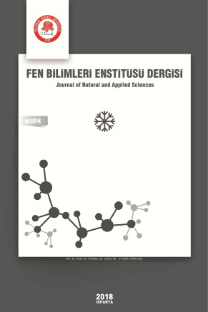Karanfillerde kök çürüklüğü hastalık etmenine (Rhizoctonia solani Kühn.) Karşı biyolojik fungisit "RootShield" (Trichoderma harzinum Rifai KRL-AG2)' in etkisi
bitki patojen mantarlar, antagonistler, Rhizoctonia solani, karanfil, mantar hastalıkları, biyolojik kontrol ajanları, biyolojik kontrol, kök çürükçülleri, mantar öldürücüler, Trichoderma harzianum
The effect of a biological fungicide "RootShield" (Trichoderma harzianum Rifai KRL-AG2) against to a causal agent (Rhizoctonia solani) of root rot disease in carnations
plant pathogenic fungi, antagonists, Rhizoctonia solani, carnations, fungal diseases, biological control agents, biological control, root rots, fungicides, Trichoderma harzianum,
___
- Agrios, G. N., 1997. Plant Pathology, Academic Press, USA, 635 pp.
- Anonymous ,1999. Tarımsal üretim potansiyelinin değerlendirilmesi ve tüketim kalıplarında beklenen gelişmeler özel ihtisas komisyonu.T. C. Başbakanlık Devlet Planlama Teşkilatı Müsteşarlığı. Yayın No: DPT 2464-ÖİK. 515.
- Basım, H.,1999. Biyolojik bir fungisit (Rootshieid {Trichoderma harzianum Rifai KRL-AG2))' in domates fide kök çürüklüğü etmenlerine {Rhizoctonia spp,, Pythıum spp., Fusarium spp.) karşı etkinliğinin araştırılması. GAP 1. Tarım Kongresi, Şanlıurfa, 26-28 Mayıs, 129- 136.
- Basım, H., Öztürk, Ş. B., Yeğen, O. 1999. Biyolojik bir fungisit, Planter Box {Trichoderma harzianum Rifai T-22)' in pamuk fide kök çürüklük etmenlerine (Rhizoctonia solani, Fusarium sp.) karşı etkinliğinin araştırılması. GAP I. Tarım Kongresi, 26-28 Mayıs, Şanlıurfa, 137- 144,
- Basım, H., Ünlü, A., Ersoy, A., 2000. Kavunlarda solgunluk hastalık etmeni Fusarium oxysporum f. sp.melonis' e karşı biyolojik mücadele olanaklarının araştırılması. III. Sebze Tarım Sempozyumu, İsparta, 11- 13 Eylül, 193-198.
- Benhamou, N., Chet, N., 1993. Hyphal interactions between Trichoderma harzianum and Rhizoctonia soîani: Ultrastructure and gold cytochemistry of the mycoparasitic process. Phyto¬pathology, 83, 1062-1071.
- Benhamou, N., Chet, N. ,1996. Parasitism of sclerotia of Sclerotium rolfsii by Trichoderma harzianum: Ultrastructural and cytochemical aspects of the interaction. Phytopathology ,86, 405-416.
- Chang, Ya-C, Chang, Yıh-C., Baker, R, Kleifeld, O. and Chet, L, 1986. Increased growth of plants in the presence of the biological control agent Trichoderma harzianum. Plant Disease, 70, 145-148.
- Chung, Y. R, Hoitink, H. A. J. ,1990. Interactions between thermophilic fungi and Trichoderma hamatum in supression of Rhizoctonia damping-off in a bark compost-amended container medium. Phytopathology, 80,73-77.
- Datnoff, L. E., Nemec, S. and Pernezny, K. ,1995. Biological control of Fusarium crown and root rot of tomato in Florida using Trichoderma harzianum and Glumus intraradices. Biological Control, 5,427-431.
- Ertan, N., Karagüzel, O., Kostak, S. 1996. Süs Bitkileri Alt Komisyon raporu. 63-85 pp.
- Hader, Y., Harman, G. E., Taylor, A. G.,1984. Evaluation of Trichoderma koningi and T. harzianum from NewYork soils for biological control of seed rot caused by Pythium spp. Phytopathology 74,106-110.
- Haran, S., Schickler, B., Oppenheim, A., Chet, I., 1996. Differential expression of Trichoderma harzianum chitinases during, mycoparasitism. Phytopathology, 86, 980-985.
- Kwok, O. C. H., Fahy, P. C., Hoitink, H. A. and Kuter, G. A, 1987. Interactions between bacteria and Trichoderma hamatum in supression of Rhizoctonia damping-off in bark compost media. Phytopathology 77, 1206-1212.
- Lifshitz, R,Windham, M. T. and Baker, R, 1986. Mechanism of biological control of preemergence damping-off of pea by seed treatment with Trichoderma spp. Phytopathology 76, 720-725.
- Mihuta-Grinmm, I., Rowe, R C. ,1986. Trichoderma spp. as biocontrol agents of Rhizoctonia damping-off of radish in organic soil and comparison of four delivery systems. Phytopathology, 76, 306-312.
- Rastgelen, C, 1979. Gıda, tarım ve hayvancılık Bakanlığının Türkiye süs bitkileri konusundaki görüşleri. Seminer notları, Yalova.
- Sivan, A. and Chet, I. 1989. The possible role of competition between Trichoderma harzianum and Fusarium oxysporum on rhizosphere colonization. Phytopathology 79, 198-203.
- Windham, M. T.s Elad, Y. and Baker, R, 1986. A mechanism for increased plant growth induced by Trichoderma spp. Phytopathology ,76, 518-521.
- ISSN: 1300-7688
- Yayın Aralığı: 3
- Başlangıç: 1995
- Yayıncı: Süleyman Demirel Üniversitesi
Differant morphological characters of some taxon belonging to the flora of Turkey
Bıldırcınlarda yem formunun besi performansı ve kesim sonuçları üzerine etkileri
Duygu KAŞIKÇI, Cemal ERENSAYIN, SEDAT AKTAN, H. İbrahim AKÇADAĞ
Stoksuzluğa izin verilmesi durumunda öğrenme etkilerine sahip bir ekonomik imalat miktarı modeli
Burdur ve civarı tatlısularında yayılış gösteren gastropoda (Salyangozlar) türleri
M. Zeki YILDIRIM, Belgin KARAŞAHİN, Hasan KALYONCU
Grup büyüklüğünün bıldırcınlarda besi performansı üzerine etkileri
İşletmelerde üretim-pazarlama uyumunun toplam performansa katkısına yönelik bir model analizi
Türkiye tarımında ortak tarım politikasına uyum ve küreselleşmenin yeri
